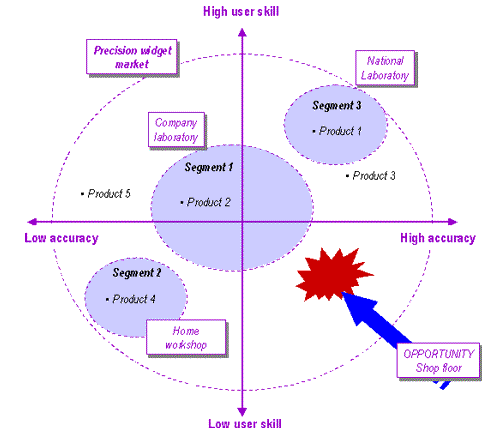Market segmentation
For all product types and markets, different groups of customers will have different requirements. The market for any product can be split into individual segments, where each segment describes a number of customers with similar requirements, tastes, characteristics, interests, lifestyles or responses to the 'marketing mix'.
Effective segmentation can indicate gaps in the market and provides insights into the requirements of different types of users, enabling potential product offerings to be carefully positioned to meet those needs.
Method
The process of market segmentation can considered in four stages:
Define the total market
The way a market is defined impacts upon how it can be segmented. For example, a market could be called 'small cars' or 'personal transport', depending upon the definition, the segments which emerge could be very different.
Choose the bases of segmentation
A market can be segmented in many different ways. For the small car market, many bases of segmentation may be appropriate, including age, lifestyle, distance travelled, occupation etc. There is no correct approach, but well chosen bases help to describe the motivations, desires or characteristics of users and reflect the benefits which different clusters of users may derive from the product. It is useful to try a range of different bases. Where possible avoid bases which describe price and chose bases which reflect the demographics or behaviour of users.
Draw chart & map products and segments
The perceptual map (illustrated) provides a visual way of representing the market and mapping your own and competitive products. An effective map will enable clusters of users to be identified and where possible, named. This is especially helpful when trying to determine who to involve in customer research. The relative position of products is dependent upon the perceptions of users & customers.
Target an opportunity and position a solution
Having positioned the different competitive offerings, it should be possible to identify gaps in the market and target opportunities for new products. By understanding the needs of a segment, it is possible to closely position a new product to match these user requirements.

Notes
For all product types and markets, different groups of customers will have different requirements. The market for any product can be split into individual segments, where each segment describes a number of customers with similar requirements, tastes, characteristics, interests, lifestyles or responses toto the 'marketing mix'.
Further reading
- Dibb, S. and Simkin, L. (1996) , The Market Segmentation Workbook: target marketing for Marketing Managers , Thomson Learning
- McDonald, M. and Dunbar, I. (2004) Market Segmentation: how to do it, how to profit from it , Butterworth Heinemann
- Weinstein, A. (2004) Handbook of Market Segmentation , Haworth Press
For more information, please contact:
T: +44 1223 764830









